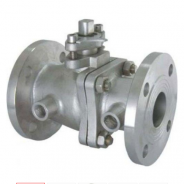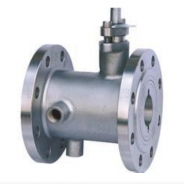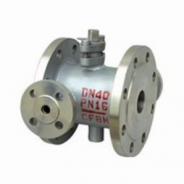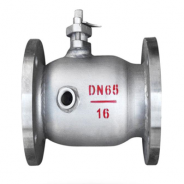Jacketed Ball Valve
Jacketed ball valve manufacturer and supplier,mainly produce soft seated and metal seated jacketed ball valve, manual,electric,pneumatic actuated jacketed ball valve, 2 way and 3 way jacketed ball valve, steam,thermal oil,bitumen,asphalt,pitch,molten sulfur,sulphur jacketed ball valve and other jacket ball valves.
Jacketed ball valve is a type of ball valve with constructed or welded jackets on the valve body. The jackets are used for heating or cooling the media flowing through the valve to prevent crystallization or seizing. Jacketed ball valve used in heating applications are designed with heating jackets that help to provide high-temperature steam or oil over the valve body and trim parts to ensure the pipe media maintains the required viscosity. Jacketed ball valve is designed with oversized flanges to help enhance sufficient clearance for bolting to the pipeline. Jacketed ball valve can be operated by an actuator or manually.
The various types of jacketed ball valve include single-piece jacketed ball valve, two-piece jacketed ball valve, three-piece jacketed ball valve, and three-way jacketed ball valve. The features of jacketed ball valves include fire-proof, heating/cooling jackets, high performance, quickly in action, and lubrication-free among others.
Jacketed ball valve is used in various applications such as food industries, processing molten or liquid sulfur, fertilizer production, rubber processing, soap manufacturing, production of polymers, and bitumen processing among others. Some of the advantages of using a jacketed ball valve include versatility, durability, quick to open and close, high strength, fire-proof, repairable, compact and simple design, and leakage proof.
What is a jacketed ball valve?
Jacketed ball valve is the ball valve that have jackets that help in heating or cooling the flow media to prevent seizing or crystallization. Jacketed ball valves for heating applications have good heating jackets to provide high-temperature oil or steam over the valve body and ball parts to keep the media in the required state. This is mostly used in media such as liquid sulfur and bitumen. Jacketed ball valves have jackets that cover the body from one flange end to the other flange end. The valve body is altered by adding oversized flanges. For instance, a jacketed ball valve with a nominal diameter of 2-inch would have a flange of 3-inch diameter. The oversize flange helps to allow sufficient bolting clearance space.
Jacketed ball valves are used to handle very viscous media that can easily solidify at ambient temperature. Some of the fluids that can be used as heating media in jacketed ball valves include thermic fluid oil, steam, and hot water. All jacketed ball valves are tested after constructing or welding jackets to the valve body. The standard jacketed ball valve is made using cast carbon steel and stainless steel materials. Jacketed ball valves can also be made of other special materials upon request by the customer. Connections that can be used between the valve and the pipeline include threaded end and flanged end connections. Jacketed ball valves can be operated manually or actuated using valve actuators (electric and pneumatic actuators).
How does a jacketed ball valve work?
Jacketed ball valve works by using a ball with a bore at its middle section. To open a jacketed ball valve, the handle is turned anticlockwise for a quarter turn. The rotary motion applied on the handle for manual valves is transmitted through the valve stem to the valve ball. This makes the ball rotate for the same quarter (90o degrees). When the ball turns 90o degrees it makes the bore collinear with the pipeline. As such, fluid flows through the valve to the next section of the pipeline. The same working principle applies to an actuated jacketed ball valve. The only difference between the actuated and the manual valve is that the actuated one uses an actuator to provide the rotational force needed to open or close the valve. To close the jacketed ball valve, the handle/actuator turns 90o degrees in the clockwise direction which makes the ball rotate in the same direction. This makes the ball bore block the fluid flow as it becomes perpendicular to the pipeline. To ensure the fluid flowing through the valve is kept at the required viscosity, hot media is passed through the valve jackets. This helps to release heat on the media. This heat helps to reduce media viscosity so that it does not stick to the jacketed ball valve or in the pipeline. Such media include very thick bitumen, soap, polymers among others.
Types of jacketed ball valve
One-piece jacketed ball valve
This is a jacketed ball valve which is made up of one piece of cast body. One-piece jacketed ball valves are free from fluid leakage as the valves are tested after being manufactured to ensure the welded joints have no imperfections. One-piece jacketed ball valves are the cheapest valves as they consume less material relative to other valves of the same size. However, single-piece jacketed ball valves cannot be opened for cleaning or repair. These valves are disposed of when they break.
Two-piece jacketed ball valve
This is a jacketed ball valve that consists of two pieces of the body. One of the two pieces has the valve body and one end joint and the other piece consists of the trim and second joint. Two-piece jacketed ball valves can be inspected, cleaned, and repaired while in the field, unlike their single-piece counterparts. However, to repair or clean a two-piece jacketed ball valve the valve must be removed from the pipeline.
Three-piece jacketed ball valve
A three-piece jacketed ball valve is a ball valve that consists of three pieces. The three pieces are held together using bolts and nuts to form a leakage-free body. Three-piece jacketed ball valves make it possible to remove center components such as stem, ball, and seats from the pipeline without removing the jacketed ball valve from the pipeline. This feature makes a three-piece jacketed ball valve efficient for cleaning accumulated solids, replacement of the ball, gland packing, and seats. However, three-piece jacketed ball valves are more expensive relative to single and two-piece valves.
Three-way jacketed ball valve
This is a jacketed ball valve with three ports. The three ports are used as either mixing valves or diverting valves. As such there are two configurations of three-way jacketed ball valve that is the L-shaped and the T-shaped type. The L-shaped configuration of a jacketed ball valve is used to divert fluid from one direction to another. The T-shaped configuration of a three way jacketed ball valve is used to mix and divert fluid streams. When the T-shaped configuration is used to mix fluids, it gets two fluid streams from two ports which are mixed and flow out as one fluid stream. When a T-shaped configuration is used to divert fluid, it gets fluid from the inlet port and the fluid is divided into two streams flowing through the two outlet ports.
Features of jacketed ball valve
-
Jacketed ball valves have heating or cooling jackets.
-
Jacketed ball valves have high performance.
-
They are free from lubrication.
-
These valves should be simple in design.
-
Jacketed ball valves should have a low-pressure drop.
-
They must be quick in action.
-
Jacketed ball valves must have high strength and be fire-proof.
Applications of jacketed ball valve
-
Jacketed ball valves are used in food applications such as the production of vegetable oil, sauce, and chocolate among others.
-
They are used in molten or liquid sulfur processing.
-
These valves are used in the production of fertilizer.
-
Jacketed ball valves are used in the transfer of bitumen and coal tar processes.
-
They are used in the production of rubber products.
-
Jacketed ball valves are used in the manufacturing of polymer products.
-
Jacketed ball valves are used in soap manufacturing processes.
-
They are used in the manufacturing of paint and ink.
Advantages and disadvantages of jacketed ball valve
Advantages of jacketed ball valve
-
Jacketed ball valve can be cleaned, inspected, and repaired.
-
Jacketed ball valve can be used in different industries for different applications.
-
These valves are fire-proof.
-
Jacketed ball valve is durable.
-
They are compact and simple in design.
-
They can be operated manually or using an actuator according to user preference.
-
Jacketed ball valve has perfect sealing free of fluid leakage.
-
Jacketed ball valve is strong for high-temperature and high-pressure applications.
Disadvantages of jacketed ball valve
Jacketed ball valve is more expensive compared to other ball valves.
Jacketed ball valves work depending on the availability of heat to change fluid viscosity. In absence of heat, the valve may not work.
These valves work on viscous fluids which tend to cause valve blockage.
-
( Two pieces split body ball valve structure )
- Port size:DN15 x DN 40~DN150 x DN250
- Pressure: PN16 ~ 25 CLASS 150/300LB
- Medium:According to client's need
- Temperature:-40~450℃
- Body material:WCB CF8 CF3 CF8M CF3M or others
-
( One piece integral body ball valve structure )
- Port size:DN15 x DN 40~DN150 x DN250
- Pressure: PN16 ~ 100,150LB ~ 600LB
- Medium:According to client's need
- Temperature:-40~450℃
- Body material:WCB CF8 CF3 CF8M CF3M or others
-
( Steam jacket end Connection is thread or flanged )
- Port size:DN15 x DN 40~DN150 x DN250
- Pressure: PN16 ~ 100,150LB ~ 600LB
- Medium:According to client's need
- Temperature:-40~450℃
- Body material:WCB CF8 CF3 CF8M CF3M or others
-
( Full or Partial half jacket design )
- Port size:DN15 x DN 40~DN150 x DN250
- Pressure: PN16 ~ 100,150LB ~ 600LB
- Medium:Need heating medium
- Temperature:-29~425℃
- Body material:WCB CF8 CF3 CF8M CF3M or others




